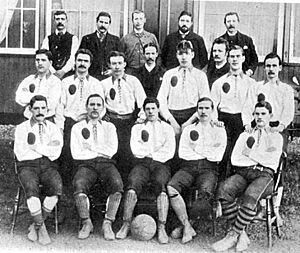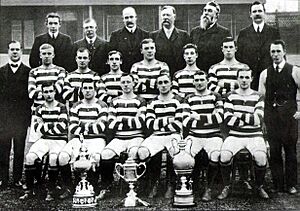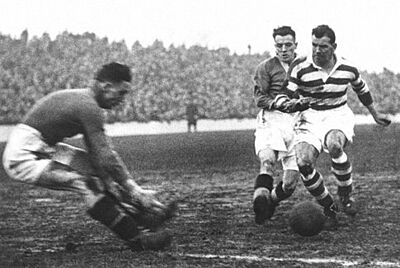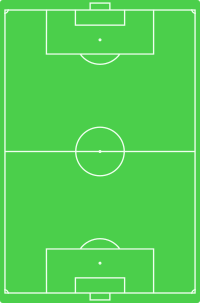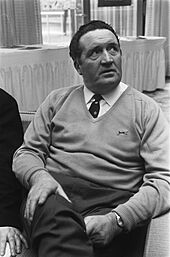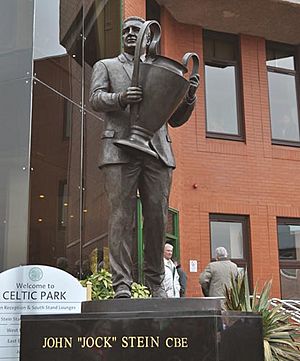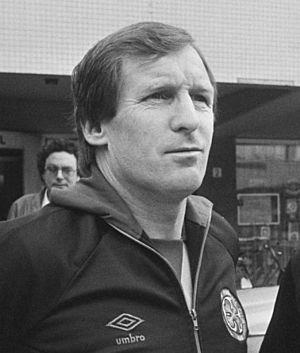History of Celtic F.C. (1887–1994) facts for kids
Celtic Football Club started in 1888 to create a team for Irish immigrants in Glasgow, Scotland. They play their home games at Celtic Park, where they moved in 1892. Celtic has always played in the top football league in Scotland, which is now called the Scottish Premiership.
The club quickly became very strong, winning six league titles in a row in the early 1900s. A big rivalry grew between Celtic and Rangers, and their matches became known as the Old Firm derby.
In 1967, under manager Jock Stein, Celtic made history by becoming the first British team to win the European Cup. Before this, only teams from Italy, Portugal, and Spain had won it. What's even more amazing is that all the players in that winning team were born within 30 miles of Celtic Park! They are famously known as the 'Lisbon Lions'.
Celtic also won nine league titles in a row from 1966 to 1974. They continued to win trophies in Scotland during the 1970s and 1980s. In 1988, their 100th year, Celtic won both the league and the Scottish Cup. In the early 1990s, the club faced some tough times, but in 1994, a businessman named Fergus McCann took over, helping the club get back on track.
Contents
How Celtic Began (1887–1897)
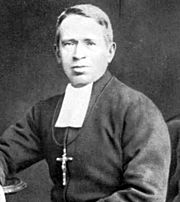
Celtic Football Club was officially started on 6 November 1887. It was founded by Brother Walfrid, an Irish Marist brother, at a meeting in St. Mary's church hall in Glasgow. His main goal was to help poor children in the East End of Glasgow by raising money for his charity, the Poor Children's Dinner Table.
Brother Walfrid was inspired by another team, Hibernian, which was also formed by Irish immigrants in Edinburgh. He suggested the name 'Celtic' to show the club's Irish and Scottish roots. The club's official nickname is "The Bhoys." This unique spelling, with an extra 'h', is thought to come from an old postcard that called the team "The Bould Bhoys," copying the spelling style of Gaelic.
Celtic played their very first official game against Rangers on 28 May 1888. Celtic won 5–2 in what was called a "friendly match." Neil McCallum scored Celtic's first-ever goal. This game started the famous rivalry known as the Old Firm. Some people think the name came from a newspaper saying the players seemed like "old firm friends." Others believe it was about how much money both clubs made from their growing rivalry.
Celtic's first uniform was a white shirt with a green collar, black shorts, and green socks. The first club badge was a green cross on a red oval. In 1889, they wore white and green vertical stripes. Finally, in 1903, they adopted the famous green and white hoops we know today.
While Brother Walfrid wanted to help charity, others saw a chance to make money from football. In August 1888, some of Hibs’ best players moved to Celtic. This caused big problems for Hibernian, but they later managed to rebuild their team.
In 1889, Celtic reached the final of the Scottish Cup in their first season in the competition, but they lost 2–1 to Third Lanark. They won their first major trophy in 1892, beating Queen's Park 5–1 in the Scottish Cup final at Ibrox Park. Sandy McMahon and John Campbell each scored twice. A few months later, the club moved to its new home, Celtic Park. The next season, they won the Scottish Football League for the first time. On 26 October 1895, Celtic set a league record by winning a home game 11–0 against Dundee.
The Willie Maley Era (1897–1940)
In 1897, Celtic became a company, and Willie Maley was chosen as the first manager. Instead of just buying experienced players, Maley focused on finding and training young talent, especially from junior teams. This worked very well! Celtic became the top team in Scottish football in the early 1900s, winning the Scottish League Championship six times in a row from 1905 to 1910. In 1907 and 1908, Celtic also won the Scottish Cup, becoming the first Scottish club to win the Double (both the league and the cup) in those years.
After 1910, some key players left, and Rangers won three league titles in a row. But Celtic still did well in the Scottish Cup, winning finals in 1911, 1912, and 1914. Players like Patsy Gallacher and Peter Johnstone helped the team. In 1914, Celtic won the league again, completing their third League and Cup Double.
During World War I, Celtic won the league four times in a row. They even had an amazing 62-match unbeaten run from November 1915 to April 1917, which was a British record for 100 years! Despite their success on the field, the war was a difficult time. Attendances at games dropped, and players' salaries were cut. Some Celtic players fought in the war, and Peter Johnstone, a popular player, sadly died in battle in 1917.
Brother Walfrid, the club's founder, passed away on 17 April 1915 at age 74. Willie Maley said that Walfrid's work for Celtic was "a labour of love."
In the 1920s, Rangers became the dominant team, winning eight league titles compared to Celtic's two. However, Celtic still won the Scottish Cup three times. A memorable Scottish Cup win was in 1925. In the final against Dundee, with Dundee leading 1–0 near the end, Patsy Gallacher scored an incredible goal. He stumbled but managed to somersault with the ball between his feet, guiding it into the net! Celtic went on to win 2–1.
The mid-1920s saw the rise of Jimmy McGrory, one of the best goalscorers in Scottish football history. In his 16-year career, he scored 550 goals, a British record that still stands today. In January 1928, McGrory scored eight goals in one league game, a 9–0 win over Dunfermline. Arsenal tried hard to sign McGrory, offering a lot of money, but he didn't want to leave Celtic. He famously said, "McGrory of Arsenal just never sounded as good as McGrory of Celtic."
In September 1931, tragedy struck the club when goalkeeper John Thomson was accidentally killed during an Old Firm match. Thomson, only 22, bravely dived for the ball and suffered a fatal head injury. He was a highly respected player, known as the 'Prince of Goalkeepers'. About 30,000 people attended his funeral.
In 1936, Willie Maley signed Mohammed Abdul Salim, the first player from the Indian subcontinent to play for a major European club. Salim played in his bare feet and impressed in two friendly games, scoring one goal and setting up three others. He later returned to India.
Celtic's performance improved in the mid-1930s with players like Jimmy Delaney and Johnny Crum. They won the league title in 1936, their first since 1926. The following year, Celtic played Aberdeen in the 1937 Scottish Cup Final. A record crowd of 146,433 people watched Celtic win 2–1 at Hampden Park. This attendance is still a record for a club match in Europe.
The 1937–38 season was Celtic's 50th anniversary. They won their 19th league title that season. In June 1938, Celtic beat Everton of England 1–0 to win the Empire Exhibition Trophy. In January 1940, Willie Maley retired at 71, after serving the club for nearly 52 years as a player and manager.
World War II (1939–1945)
Former player Jimmy McStay became manager in February 1940. He was in charge for over five years, but because of World War II, there was no official league football. Many footballers joined the war effort, so teams were often missing players and used 'guest' players instead. The main Scottish League and Scottish Cup were stopped, and smaller regional competitions were played.
Celtic didn't do very well during the war years, partly because they didn't like using guest players. They did win the Glasgow Cup in 1941 and the Glasgow Charity Cup in 1943. Some promising young players, like goalkeeper Willie Miller and forward John McPhail, emerged during this time.
To celebrate Victory in Europe Day in 1945, Celtic won the Victory in Europe Cup in a one-off match against Queen's Park. The game ended 0–0, and Celtic won based on having more corner kicks. In July 1945, McStay was asked to resign, and he later became the club's chief scout.
The Jimmy McGrory Years (1945–1965)
Jimmy McGrory returned to Celtic as manager in the summer of 1945. A big change happened in the club's leadership when chairman Tom White passed away in 1947. Robert Kelly became the new chairman. For the next 18 years, Kelly was very powerful at Celtic, even getting involved in choosing the team. This made many wonder how much say McGrory actually had.
Celtic struggled in the first few years after the war under McGrory, almost getting relegated in 1948. To help, Celtic hired Jimmy Hogan as a coach. Hogan had worked with teams across Europe and is believed to have inspired Jock Stein later on.
In April 1951, a goal from John McPhail helped Celtic beat Motherwell 1–0 in the Scottish Cup Final. This was Celtic's first major trophy since the war. Two years later, in May 1953, Celtic won the Coronation Cup, a special tournament held to celebrate the coronation of Elizabeth II. They beat strong teams like Arsenal and Manchester United.
In 1954, Celtic won their first league and cup double in 40 years, and their first league title since 1938. Jock Stein, who was a player at the time, became team captain and brought a new sense of purpose to the team. Celtic finished five points ahead in the league and had a strong defense. They won the Scottish Cup Final against Aberdeen with a goal from Sean Fallon.
The 1950s saw several important players become key figures for Celtic, including Bobby Evans, Bertie Peacock, Bobby Collins, and the very popular Charlie Tully. Tully was a showman on the field, known for his amazing dribbling skills. He was so popular that Glasgow cafes sold 'Tully ice cream'!
Bobby Collins was a tough but creative midfielder. He scored 116 goals for Celtic. However, he was sometimes strangely left out of important games, like the 1954 Cup Final and a replay in 1955 where Celtic lost to a weaker team.
On 19 October 1957, Celtic famously beat Rangers 7–1 in the Scottish League Cup final. This is still a record win in a British domestic cup final. Fans still sing about this victory, calling it "Hampden in the sun." Billy McPhail scored three goals.
After this, Celtic struggled to win more trophies under McGrory, even with talented young players like Billy McNeill, Paddy Crerand, Bertie Auld, and Jimmy Johnstone joining the team. Jock Stein and Sean Fallon both had to stop playing due to injuries in the late 1950s. Stein left to manage Dunfermline Athletic in 1960, while Fallon became Chief Coach at Celtic. Other key players also left around this time.
In the early 1960s, Celtic started playing in European club competitions. In 1962, they played against Valencia in the Inter-Cities Fairs Cup. They lost the first game 4–2 in Spain and drew 2–2 at home. The next season, 1963–64, Celtic reached the semi-finals of the European Cup Winners Cup. They beat teams like FC Basel and Dinamo Zagreb. In the semi-final against MTK Budapest, Celtic won the first game 3–0 at home. However, they lost the return game in Hungary 4–0 and were knocked out.
In Scotland, Celtic continued to struggle. By January 1965, they were not doing well in the league. On 12 January 1965, the Celtic Board decided to make changes to the management.
The Jock Stein Era (1965–1978)
Jock Stein took over as manager in 1965. He was a former Celtic player and captain. Stein is known as one of the greatest football managers ever. He led Celtic to nine Scottish League wins in a row from 1966 to 1974, which was a world record at the time.
Stein officially became manager on 31 January 1965, but he started in March to give Hibernian, his previous club, time to find a new manager. Jimmy McGrory became the club's Public Relations Officer, and Sean Fallon became Assistant Manager.
When Stein arrived, Celtic was struggling. His first game was a 6–0 win, but they still had mixed results. However, Celtic had already reached the semi-finals of the 1964–65 Scottish Cup. They beat Motherwell in a replay and then faced Dunfermline in the final on 24 April 1965. Celtic came from behind twice, and Billy McNeill scored the winning goal in the last minute, giving Celtic their first major trophy since 1957.
In August 1965, Celtic became the first British football club to have its own newspaper, The Celtic View. It started as a four-page weekly paper.
The 1965–66 season was Stein's first full season. On 23 October 1965, Celtic won their second trophy under Stein, beating Rangers 2–1 in the League Cup final. On 7 May 1966, Celtic won their first league title since 1954, finishing two points ahead of Rangers. Celtic also did well in Europe, reaching the semi-finals of the European Cup Winner's Cup, where they lost to Liverpool.
1967 was an amazing year for Celtic. The club won every competition they entered, scoring a world record 196 goals! They won the Scottish League, the Scottish Cup, the Scottish League Cup, the Glasgow Cup, and the European Cup. They won the League Cup by beating Rangers 1–0. A week later, they won the Glasgow Cup. On 6 April 1967, two goals from Willie Wallace gave Celtic a 2–0 win over Aberdeen in the Scottish Cup final. Celtic's league campaign was close, but they secured the title with a 2–2 draw against Rangers, with two goals from Jimmy Johnstone.
Celtic's European Cup journey in 1966–67 was their first time in Europe's top club tournament. They easily beat FC Zurich and Nantes. In the quarter-final, they faced Vojvodina from Yugoslavia. Vojvodina won the first game 1–0. In the return match in Glasgow, Stevie Chalmers scored to level the tie. In the final minute, Billy McNeill headed in a cross to send Celtic to the semi-final. There, Celtic played Dukla Prague from Czechoslovakia. Celtic won the first game in Glasgow 3–1. Stein used a very defensive tactic for the second game, which ended in a 0–0 draw, putting Celtic in the final.
(The Lisbon Lions)
The final was against Inter Milan at the Estádio Nacional in Lisbon on 25 May 1967. Celtic went behind after seven minutes from a penalty. But Celtic attacked constantly. In the 63rd minute, Tommy Gemmell scored with a powerful shot from 25 yards to make it 1–1. With about five minutes left, Stevie Chalmers scored the winning goal. Celtic became the first British team, and the first from outside Spain, Portugal, or Italy, to win the European Cup.
Jock Stein said after the match, "Winning was important, but it was the way that we won that has filled me with satisfaction. We did it by playing football; pure, beautiful, inventive football."
All the players in that winning team were born within 30 miles of Celtic Park. They became known as the 'Lisbon Lions'. The east stand at Celtic Park is named after them, and the west stand is named after Jock Stein. A statue of captain Billy McNeill holding the European Cup is outside Celtic Park.
Two weeks later, on 7 June 1967, Celtic played Real Madrid in a friendly match. Jimmy Johnstone was amazing, and even the Spanish fans cheered for him. Celtic won 1–0.
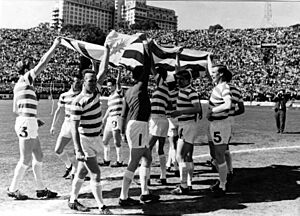
The next season, Celtic played Racing Club from Argentina in the Intercontinental Cup. Celtic won the first game 1–0, but the match was very rough. The second game in Argentina was even worse, with lots of fouls. Racing Club won 2–1. A third deciding game was played in Uruguay. This game was chaotic, with six players sent off. Racing Club won 1–0.
Celtic put this difficult experience behind them and won their third league title in a row in 1967–68. They also won the League Cup. In 1968–69, Celtic won all three major domestic trophies (League, Scottish Cup, and League Cup) – a 'treble'. This included a big 4–0 win over Rangers in the Scottish Cup Final, which was Celtic's 50th major trophy.
Celtic reached the European Cup Final again in 1970. They beat Benfica and then faced English champions Leeds Utd. Celtic won the first game 1–0. The return match was played at Hampden Park in front of 136,505 fans, a record for a European club game. Leeds scored first, but Celtic came back to win 2–1 and reach the final.
The final was on 6 May 1970 against Dutch team Feyenoord. Celtic were expected to win, and Tommy Gemmell scored first. But Feyenoord played better and won 2–1 after extra time.
In the early 1970s, a group of young players from the reserves, known as the 'Quality Street Gang', emerged. This group included Danny McGrain, Kenny Dalglish, and Lou Macari. They helped Celtic reach the European Cup semi-finals twice more. In 1972, they lost on penalties to Inter Milan. In 1974, they lost to Spanish team Atlético Madrid.
The match against Atlético Madrid was very heated. In the first game, Atlético players were very rough, and three of them were sent off. The game ended 0–0. In the second game in Spain, Atlético won 2–0.
On 6 May 1972, Celtic's Dixie Deans scored a hat-trick in the Scottish Cup final, the first since 1904. Celtic beat Hibernian 6–1. One of Deans' goals was particularly famous: he rounded the goalkeeper twice before scoring, and then celebrated with a spectacular somersault!
Celtic won their ninth league title in a row at the end of the 1973–74 season, matching the world record. They didn't win the league the next year, but they won the Scottish Cup, beating Airdrie 3–1 in the final on 3 May 1975. This was captain Billy McNeill's 822nd and final game for the club. McNeill, nicknamed 'Cesar', had been a key part of Celtic's success for 17 years. This cup win was his 23rd major medal as a player.
Stein was seriously injured in a car accident in 1975 and spent a year recovering. When he returned for the 1976–77 season, he signed defender Pat Stanton and midfielder Alfie Conn. Conn was a surprising signing because he had played for Rangers before. Celtic went on to win their tenth league and cup double, beating Rangers 1–0 in the cup final. Young players like Tommy Burns and Roy Aitken were also emerging.
The next season, Stein's last as manager, was disappointing. Celtic struggled after Kenny Dalglish left for Liverpool and key players were injured. They finished fifth in the league and lost in the cups.
In May 1978, Billy McNeill became the new manager, with John Clark as his assistant. Jock Stein left Celtic in August 1978 to manage Leeds United.
Jock Stein is remembered as one of the most important people in Celtic's history. He brought Celtic back to being the top team in Scotland and made them a respected force in Europe. Stein was also very good at managing people and understanding the mental side of the game, which was ahead of his time. He inspired many future managers, like Sir Alex Ferguson.
Billy McNeill and Davie Hay (1978–1991)
Billy McNeill, the former player and captain of the Lisbon Lions, became manager in August 1978. With Danny McGrain back from injury and new signings like Davie Provan and Murdo MacLeod, McNeill strengthened the team. In May 1979, Celtic played Rangers in their final league game. A win would give Celtic the league title. Celtic were 1–0 down at half-time and had a player sent off. But they fought back with goals from Roy Aitken and George McCluskey to lead 2–1. Rangers equalized, but then a Rangers defender accidentally scored an own goal, putting Celtic 3–2 up. In the final minute, Murdo MacLeod scored a powerful shot to seal a dramatic 4–2 win and the league title.
The next season, Celtic reached the quarter-finals of the European Cup, beating Real Madrid 2–0 in the first game at home. But they lost 3–0 in Spain and were knocked out. Celtic also lost the league title to Aberdeen. However, they won the Scottish Cup, beating Rangers 1–0 after extra time in May 1980. The end of that game was famous for a riot between rival fans on the pitch.
McNeill led Celtic to two more league titles in 1981 and 1982. Young players like Charlie Nicholas, Paul McStay, and goalkeeper Pat Bonner became important. By 1983, Nicholas was a very exciting player, scoring 48 goals in one season. He scored against Ajax in Europe, in the League Cup Final win over Rangers, and two goals in a 4–2 win over Rangers at Ibrox. Nicholas's great form attracted big English clubs, and he moved to Arsenal for £750,000.
Paul McStay made his league debut at 17. His family had a strong connection to Celtic, with his great-uncles and older brother also playing for the club. Paul became a key player and was recognized internationally.
McNeill had won a trophy in each of his seasons as manager, even with the rise of new strong teams like Aberdeen and Dundee United. However, he had disagreements with the chairman and about transfer funds. McNeill asked for a new contract and a pay rise, but the board refused. Feeling disrespected, McNeill left the club in June 1983 to join Manchester City.
Another former player, David Hay, took over from McNeill in July 1983. In his first season, Celtic finished second in all domestic competitions. New striker Brian McClair scored 32 goals. The next year, Celtic had a difficult time in the European Cup Winner's Cup against Rapid Vienna. After a rough first game, Celtic won the return match 3–0 at home. But the game was very bad-tempered, with objects thrown from the crowd. Rapid Vienna appealed, and UEFA ordered a replay in Manchester. Celtic lost 1–0. This incident showed problems with UEFA and the Celtic board.
In 1984, Celtic started having a sponsor's logo on their shirts for the first time. The double glazing company CR Smith was the sponsor.
In May 1985, David Hay won his first trophy as manager. Celtic came from behind to beat Dundee United 2–1 in the Scottish Cup final. Davie Provan scored a brilliant free-kick, and Frank McGarvey scored the winning goal in the last five minutes.
The following year, Celtic won the league title on the very last day of the season in an incredible way. They needed to win their final game against St Mirren by at least three goals and hope that Hearts would lose to Dundee. Celtic led 4–0 at half-time. Then, Albert Kidd scored two goals for Dundee against Hearts, meaning Hearts lost 2–0. Celtic's 5–0 win meant they won the league title on goal difference!
The next season, Rangers spent a lot of money and won the league. Celtic lost to Rangers in the League Cup Final. Davie Hay was sacked in May 1987, and Billy McNeill returned as manager.
When Billy McNeill came back in 1987, many players left, and he signed new ones like Chris Morris, Billy Stark, and Andy Walker. Later, Frank McAvennie and Joe Miller joined.
This new Celtic team, captained by Roy Aitken, quickly played well together. They went on a 31-game unbeaten run and won a historic League Championship and Scottish Cup double in the club's 100th anniversary season. Paul McStay had his best season, winning player of the year awards. Celtic won the league title on 23 April 1988 with a 3–0 win over Dundee. In the Scottish Cup semi-final, Celtic were 1–0 down to Hearts with three minutes left, but they scored two late goals to win. In the Cup Final on 14 May 1987, Dundee United led, but Frank McAvennie scored twice, including the winner in the last minute, to win the Cup for Celtic.
However, the next season was disappointing in the league. But Celtic did win the Scottish Cup in 1989, beating Rangers 1–0 with a goal from Joe Miller.
The 1989–90 season was also not good. Celtic lost in Europe and finished fifth in the league. They reached the Scottish Cup Final in 1990 but lost on penalties to Aberdeen. During this season, captain Roy Aitken left, and Paul McStay became the new captain.
In May 1990, new people joined the Celtic board, but there were disagreements, leading to public arguments within the club's leadership for several years.
The 1990–91 season saw Celtic's league form drop again. They reached the Skol Cup Final in October but lost to Rangers. In December 1990, Celtic appointed their first Chief Executive, Terry Cassidy. On the field, Celtic beat Rangers 2–0 in a Scottish Cup quarter-final, a very wild game with four players sent off. But they then lost to Motherwell in the semi-final.
After another poor season, Billy McNeill left the club at the end of the 1990–91 season.
Liam Brady and Lou Macari (1991–1994)
Liam Brady became Celtic's manager shortly after McNeill left. He was only the eighth manager in over 100 years, and the first who had not played for the club before. Despite his great career as a player, he struggled to bring success to Celtic as a manager.
Brady made several player changes in his first season. He signed striker Tony Cascarino for a club record £1.1 million, but Cascarino was not successful and later moved to Chelsea. Brady also signed defenders Gary Gillespie and Tony Mowbray, but both struggled with injuries.
On 23 October 1991, Celtic suffered one of their worst European defeats, losing 5–1 to Swiss side Neuchâtel Xamax in the UEFA Cup. They only managed a 1–0 win in the return game and were knocked out. In the league, Celtic finished third. They also lost in the League Cup and Scottish Cup semi-finals.
Off the field, Celtic was also having problems. They couldn't find a shirt sponsor for the 1992–93 season, so for the first time in years, their famous hoops were plain. The Chief Executive, Terry Cassidy, continued to cause controversy and was finally sacked in October 1992.
Brady made more player changes for the 1992–93 season, selling some defenders and bringing in forwards Stuart Slater and Andy Payton, and Rudi Vata, the first Albanian to play in British football. Celtic's domestic form didn't improve. They lost in the semi-final of the League Cup and were knocked out of the Scottish Cup by Falkirk. Europe offered a small break when Celtic came back from a 2–0 first-leg defeat to beat Cologne 3–0 in the UEFA Cup. John Collins was one of the few players who played well under Brady.
In the summer of 1993, Scottish-born Canadian businessman Fergus McCann was one of several people trying to take over Celtic from the existing board. These groups, along with fan groups, were known as the 'Rebels'.
Celtic got a shirt sponsor again for the 1993–94 season, with CR Smith returning. On the field, Celtic continued to struggle, and Brady left in October 1993 after a league defeat.
Lou Macari was appointed the new manager on 27 October 1993. Celtic's form did not get better. A bad 4–2 defeat to Rangers in the New Year game left them low in the league. Macari made some unsuccessful player changes. He sold Gerry Creaney, one of Celtic's few consistent goalscorers, and brought in players like Willie Falconer and Wayne Biggins.
An early Scottish Cup exit in January 1994 sealed another bad season for Celtic. However, things were changing off the field. Two groups, one led by Fergus McCann, were trying to take over the club. The Celtic Board was planning to build a new stadium. On 25 February 1994, the board announced they had funding for the new stadium. But later that day, the bank denied the funding, and the plans were criticized by the media.
In the days that followed, the Celtic Board lost all trust. On 3 March 1994, the Bank of Scotland told the board they needed to find £1 million within 24 hours, or the club would be closed down. The next day, Fergus McCann became the new owner of Celtic, and a new team of directors was appointed. Brian Dempsey, who had been involved in the campaign for change, helped with £1 million of his own money and declared, "the rebels have won."
See also


